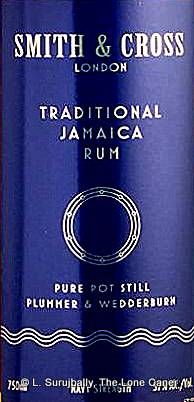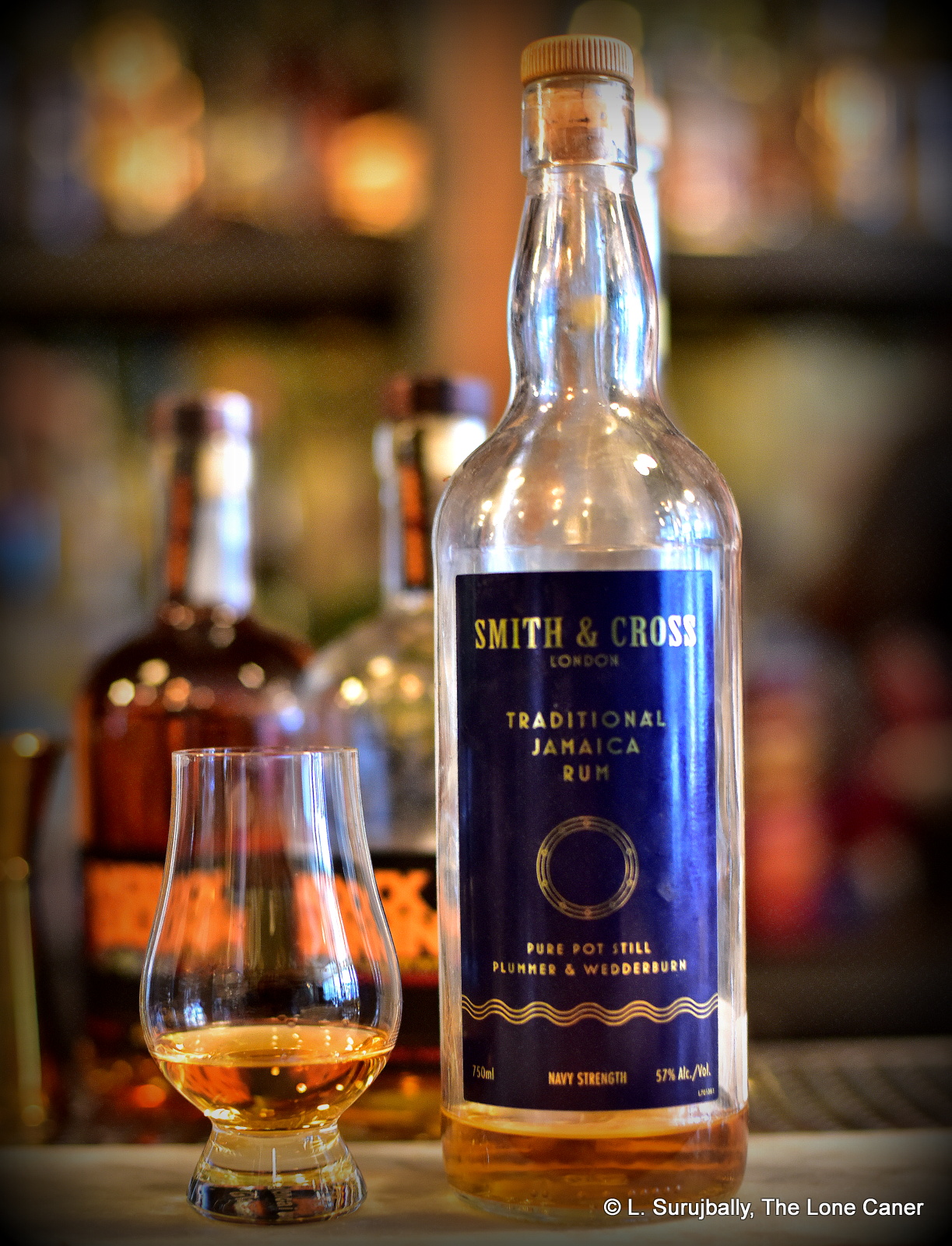Yeah, I’m chugging along behind the other reviewers, pulling late into the station on this one. The Smith & Cross Jamaican rum has been on people’s radar for ages now, so it’s not as if this review will do much except to raise its profile infinitesimally. Still, given its reputation, you can understand why, when I finally came across it – courtesy of a great bartender in Toronto who, by stocking stuff like this somehow manages to defeat the LCBO’s best attempts to dumb down the Canadian rum drinking public – both excitement and expectation warred in the cockles of my rum-soaked corpus as I poured myself a generous shot (and left Robin Wynne, bless his heart, ogling, billing and cooing at the Longpond 1941 which I provided as proof that I really do exist).
And my curiosity and enthusiasm was well-founded. Consider the geek-stats on the rum, to start with: Jamaican rum from the near-epicenter of ester-land, Hampden Estate (awesome); pure pot still product (oh yeah); growly 57% strength (damned right); unfrigged-with (now we’re talking); and overall amazing quality, (well brudderman, Ah wipin’ me eyes). What more could any funk-bomb, ester-loving, rum-swilling aficionado on a budget possibly want? I mean, a juice like this beats the living snot out of, and then wipes the floor with, something like a Diplomatico, know what I mean? No soft Spanish style column still rum here, but an aggressive in-your-face spirit that’s itching for a dust-up. With style.
It certainly did not disappoint. When you smell this, it’s like Air Traffic Control didn’t just clear me for takeoff, but for blast-off – scents burst out of the bottle and the glass in a rich panoply of rumstink (I mean that in a good way), matching just about any good Jamaican I’ve ever had, and exceeding quite a few. Although initially there was cream and unsweetened yoghurt or labneh, there was also the light fruitiness of esters and flowers, and absolutely no shortage of the righteous funk of rotting bananas and a garbage pail left in the sun (and I swear to you, this is not a bad thing). It was not, I judged, something to hurry past in a rush to get to the next one, so I let it stand, and indeed, additional aromas timidly crept out from behind the elephant in the room – some rough and jagged molasses and burnt sugar, crushed strawberries in unsweetened cream, and some dark bitter chocolate…in other words, yummy.
 While the smell and aroma were one step removed from awesome, the taste is what told the tale – it was, surprisingly enough, clean and clear, and quite spicy, redolent of olives, citrus, masala spice and a good whallop of burnt sugar. And it didn’t just exude these flavours, it seethed with them, with a sort of rough intensity that was remarkably well controlled. It also developed really well, I thought – over time (and with some water), it kept on adding to the menu: hot black tea, a combination of earthiness, of dry and musty sawdust that one might use the word “dirty” to describe without any negative connotations, and even to the very end (an hour later…I had that glass on the go for quite some time), there was still nougat and chocolate emerging from the glass. Oh and the finish? Just excellent – long, crisp, funky, with salt and vinegar chips, creaminess and driness all fighting to get in the last word. I have just about zero complaints or whinges about this one.
While the smell and aroma were one step removed from awesome, the taste is what told the tale – it was, surprisingly enough, clean and clear, and quite spicy, redolent of olives, citrus, masala spice and a good whallop of burnt sugar. And it didn’t just exude these flavours, it seethed with them, with a sort of rough intensity that was remarkably well controlled. It also developed really well, I thought – over time (and with some water), it kept on adding to the menu: hot black tea, a combination of earthiness, of dry and musty sawdust that one might use the word “dirty” to describe without any negative connotations, and even to the very end (an hour later…I had that glass on the go for quite some time), there was still nougat and chocolate emerging from the glass. Oh and the finish? Just excellent – long, crisp, funky, with salt and vinegar chips, creaminess and driness all fighting to get in the last word. I have just about zero complaints or whinges about this one.
So a few other tidbits before I wrap up the show. Strictly speaking, this is a blend of two styles of pot-stilled rum, Plummer and Wedderburn. These are not types of still (like John Dore and Vendome, for example) but two of the four or five main classifications the British used to type and identify Jamaica rums in the late 19th and early 20th century – Long Pond, for example, was much known for the Wedderburn profile, a heavier bodied rum somewhat distinct from the more medium bodied Plummer style. Both have massive dunder and esters in there, so for Smith & Cross (who have been around in the UK in one form or another since the 1780s) to have brought this kind of style back out into the market several years back, when easier column-still sipping fare was more the norm, deserves quite a few accolades. The rum, as noted above, is a blend of almost equal parts Wedderburn and Plummer, with the Wedderburn aged for less than a year, and the Plummer portion split between parts aged 18 months and parts for 3 years, in white oak. Frankly, I’d love to see what a really (tropical) aged version of this rumzilla would be like, because for now the youth is apparent…though fortunately it’s neither distracting nor disqualifying on that score.
The Smith & Cross reminded me a lot of the Compagnie des Indes’s 2000 14 year old, also from Hampden, but not as good as the CDI Worthy Park 2007. There was much of the same sharp richness matched against something of a ghetto bad boy here, like an educated gentleman who knows just when to stop being one and belt you a good one. If you’re not into full proof Jamaican rums showcasing heavy dunder and funky flavours that batter the senses and skewer the palate, then this is likely not a rum for you. But for those who are willing to weather its force and scalpel-like profile, it is one that reminds us what Jamaicans used to be like and what they aspire to now…and points the way to a re-emergence of a style that has for many years been hidden from view and is now getting the praise that always should have been its right.
(88/100)
Background Notes
Smith & Cross, it should be emphasized, is a “created” rum, not one that is made by its distillery of origin (i.e., principally Hampden). In point of fact, it is made by Scheer, based on specifications provided by Haus Alpenz, a European spirits distributor who have Scarlet Ibis and Batavia Arrack under their umbrella. The story goes that around 2006, Dave Wondrich (author of “Punch” and “Imbibe” books) was sitting in the Pegu Club NY with the Alpenz’s American importer, Eric Seed, and the latter asked him what rums and styles unavailable in the US he should be importing (following on from an earlier convo Seed had had with Jim Meehan about spirits in general). Wondrich knew that the sort of Jamaican rums called for in old cocktail recipes were all but unavailable in the US and he answered “A high ester Jamaican.” (“That’s interesting in and of itself because I think the current rum world has forgotten how bereft NA was of those products as recently as a decade ago,” remarked Dwayne Stewart, when we were discussing this in September 2020). Audrey Sanders, (owner of the Pegu) stopped by the table and reinforced what Dave was saying, and as a direct result of that conversation, Seed went to Scheer and asked them to create a funkier Jamaican blend…and so Smith & Cross was born.
As for the name. “Smith & Cross” is a combination of two old London firms’ names dating back to 1788: Smith & Tyers, and White Cross, sugar refiners and blenders whose premises were located along Thames Street by the London Docks. The partners were extensively involved in the rum trade, especially from Jamaica, but were eventually taken over by Hayman Distillers, another London company which was formed in 1863 – they specialized in gin themselves. At the time when Alpenz was putting together its new blended Hampden Plummer/Wederburn rum with Scheer, they had some commercial connections with Hayman, wanted an old fashioned sounding name with Jamaican connections and it’s not a stretch to suggest a gentleman’s agreement to be able to use Smith & Cross as the name of their new rum. (Hayman is now involved in another rum enterprise, Charles Merser & Co, but that’s separate from this brief bio.)

So, Hampden makes 2 styles of Jamaican rum? Interesting… Is it safe to say Appleton is more of a Plummer style?
I just tried this for the first time a month ago. I have had a bottle sitting for 5-10 years and finally got around to trying it. I like it a lot. A very unapologetic rum. Nice for sipping and probably very useful in cocktails also.